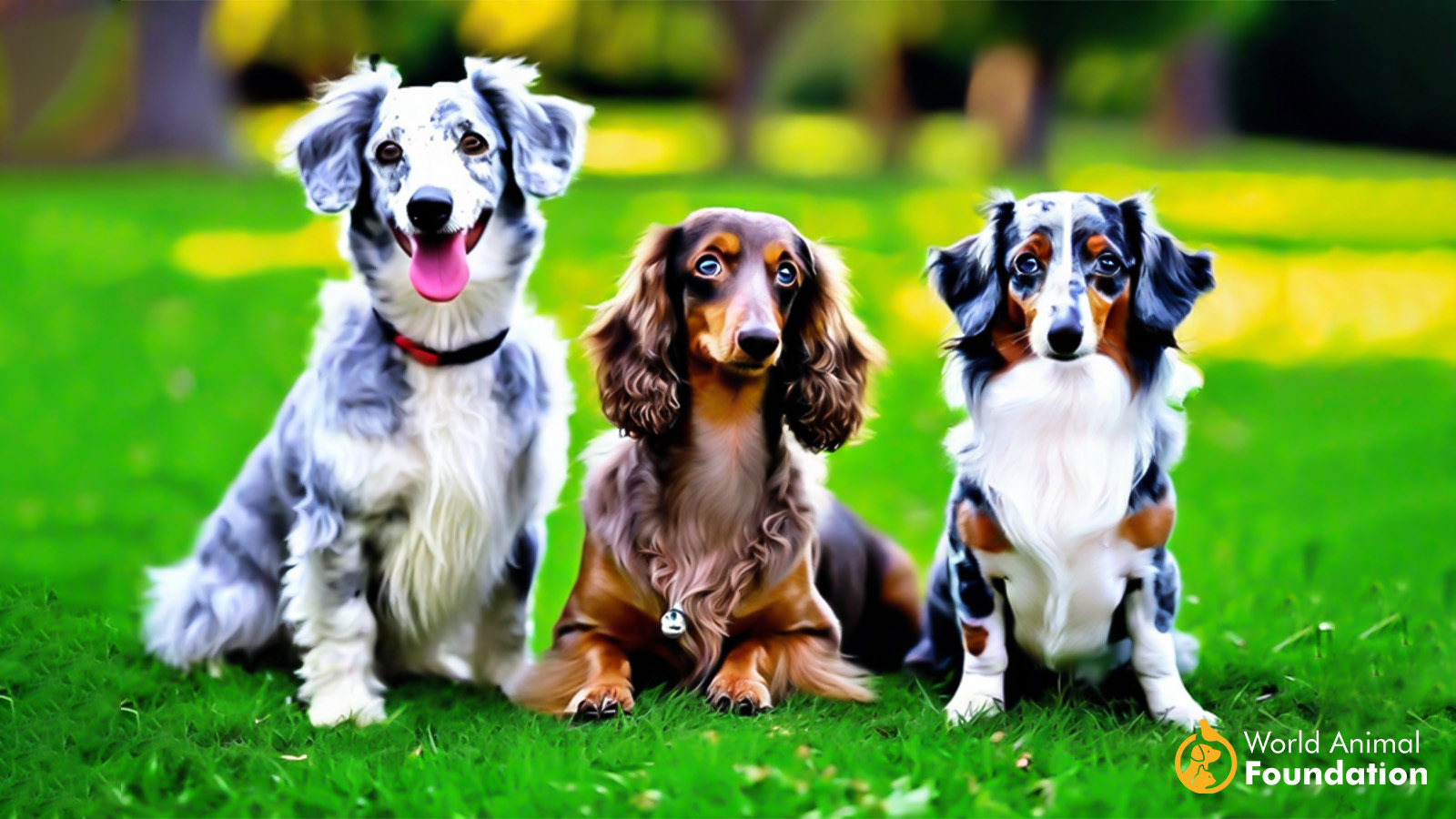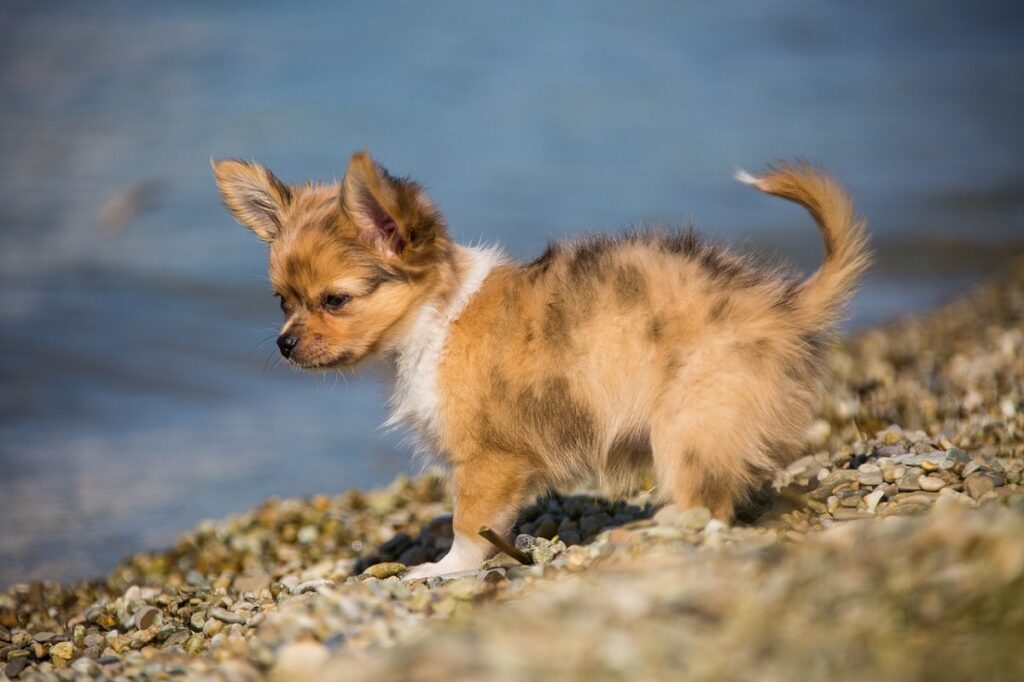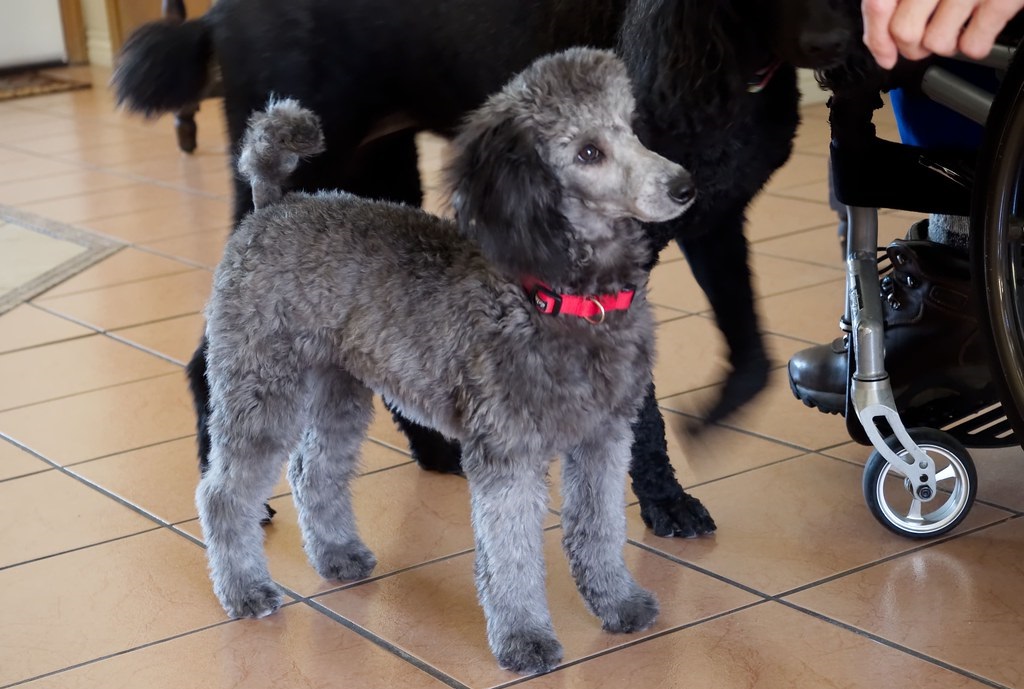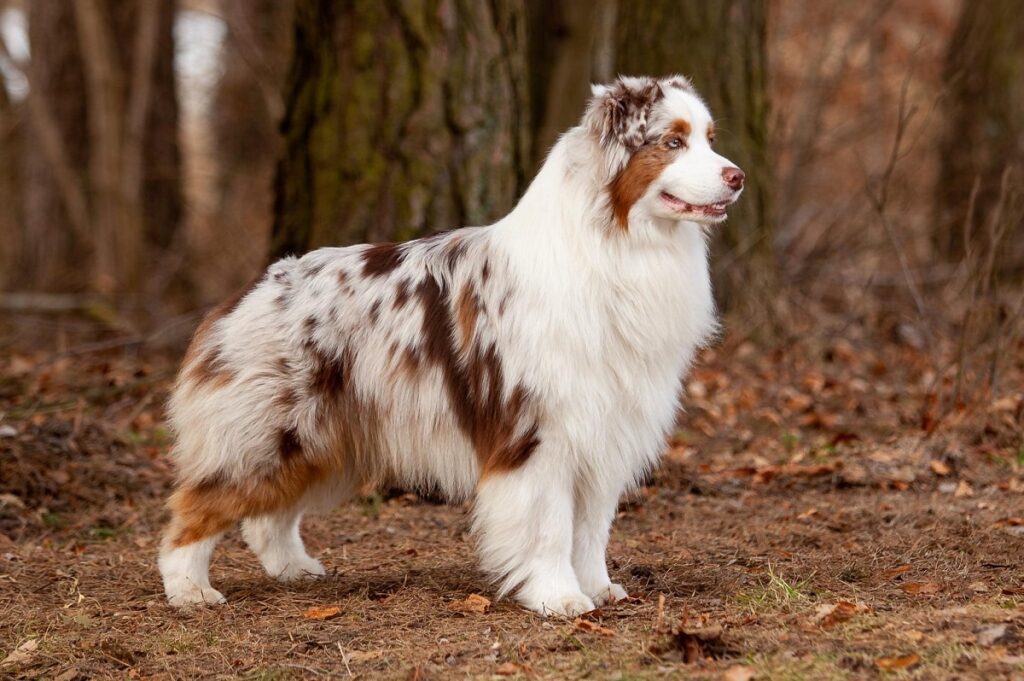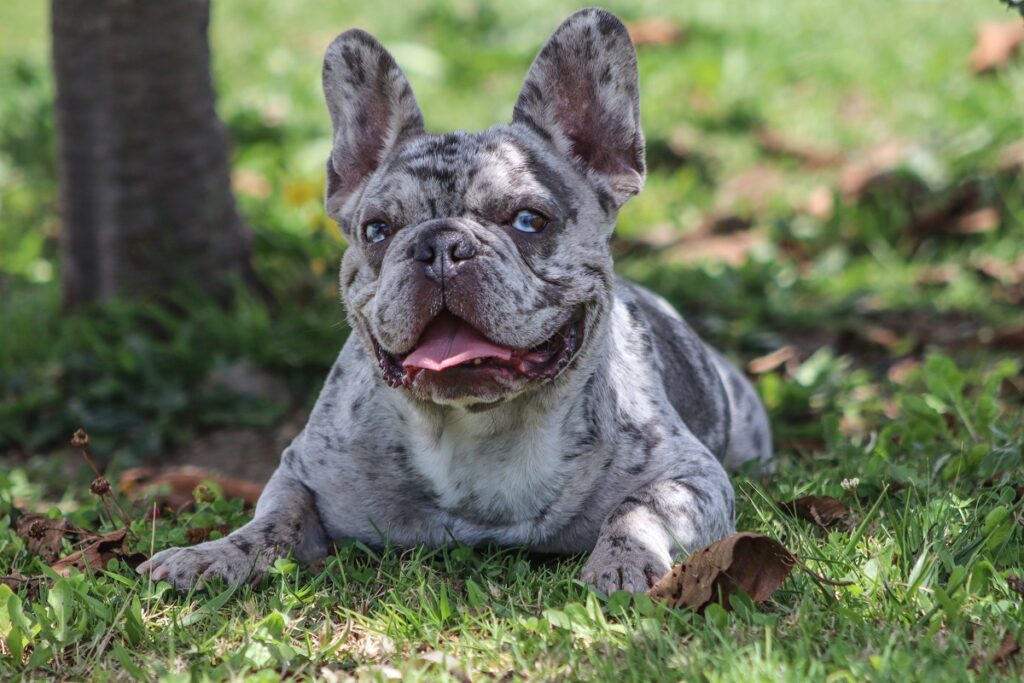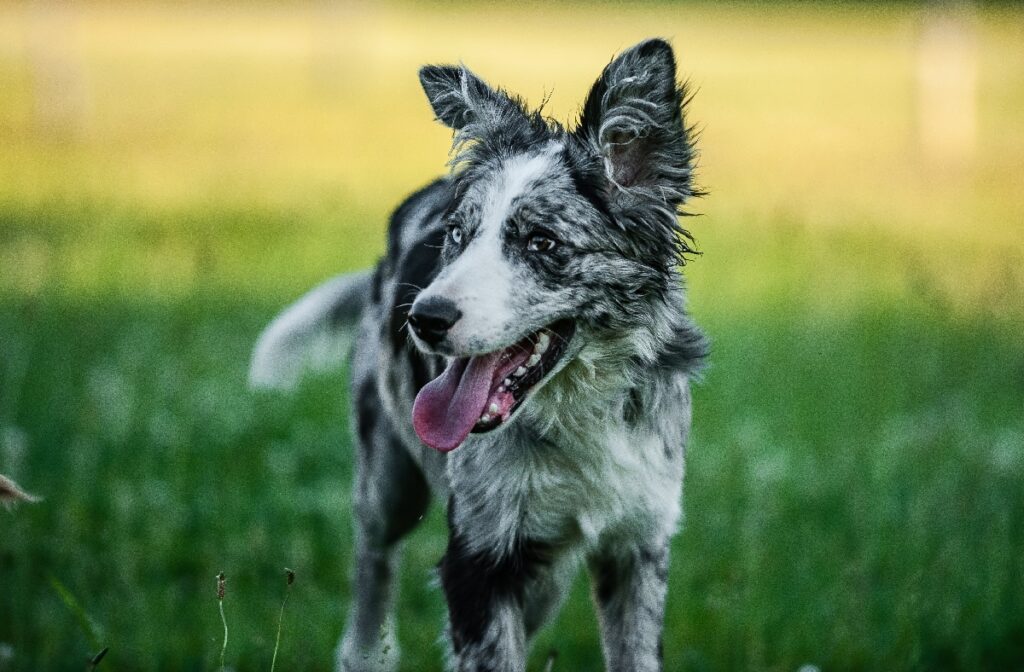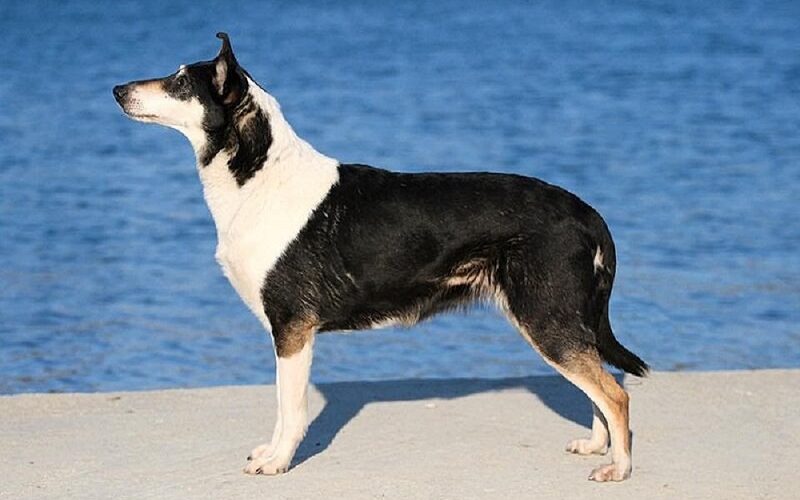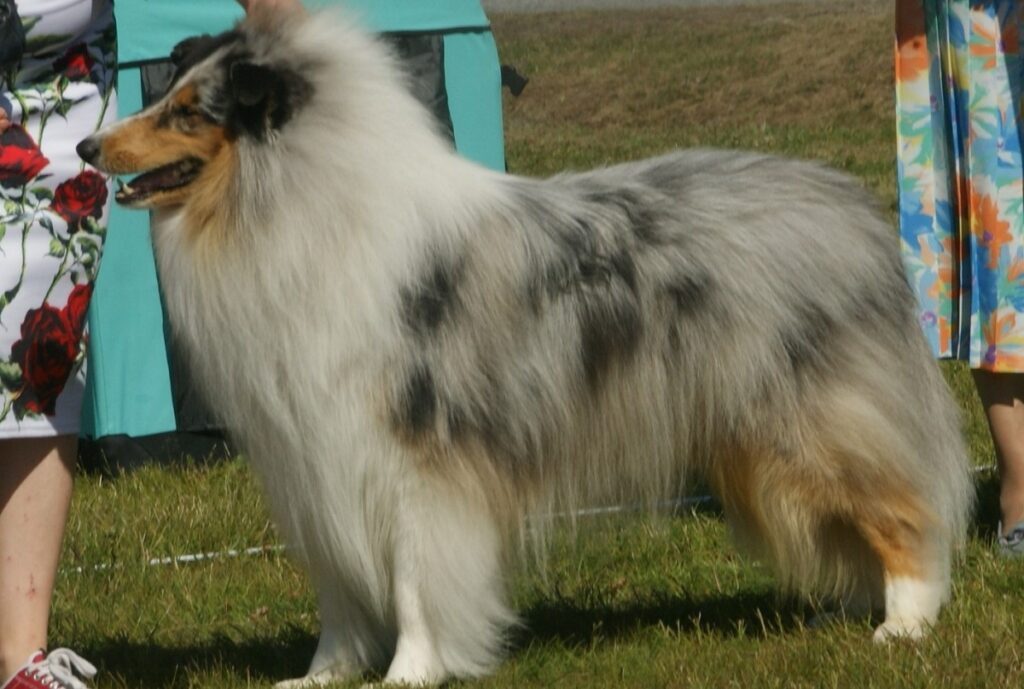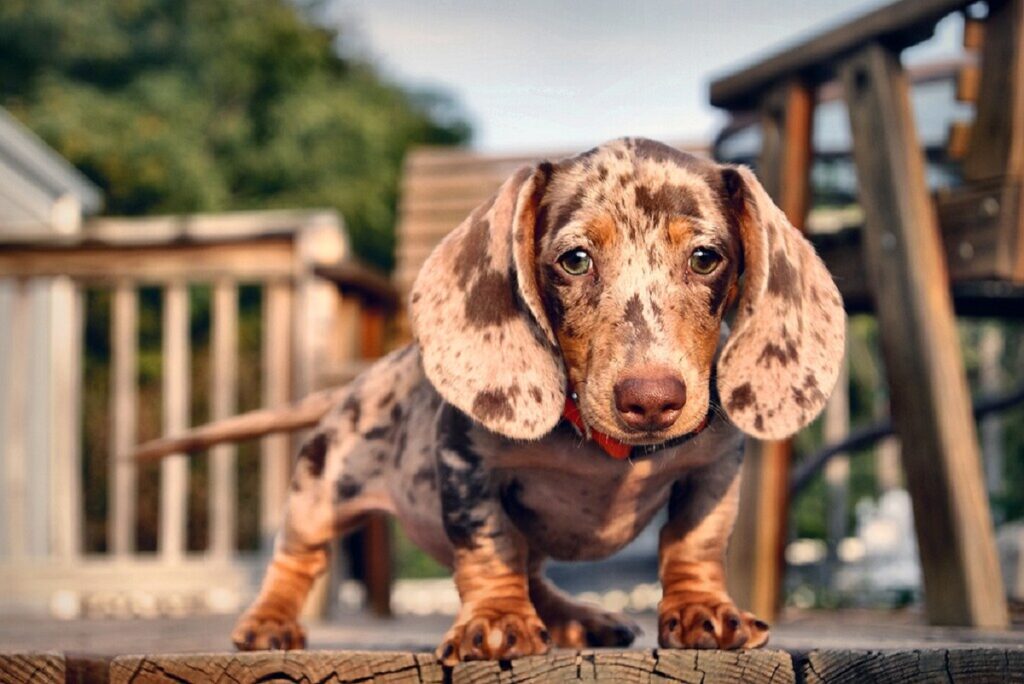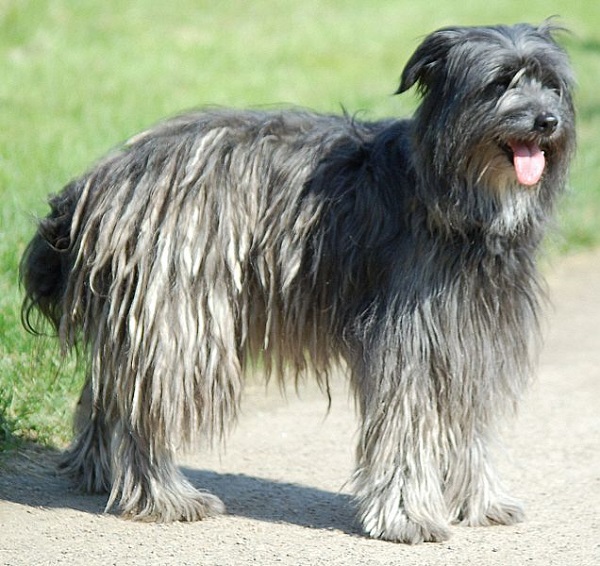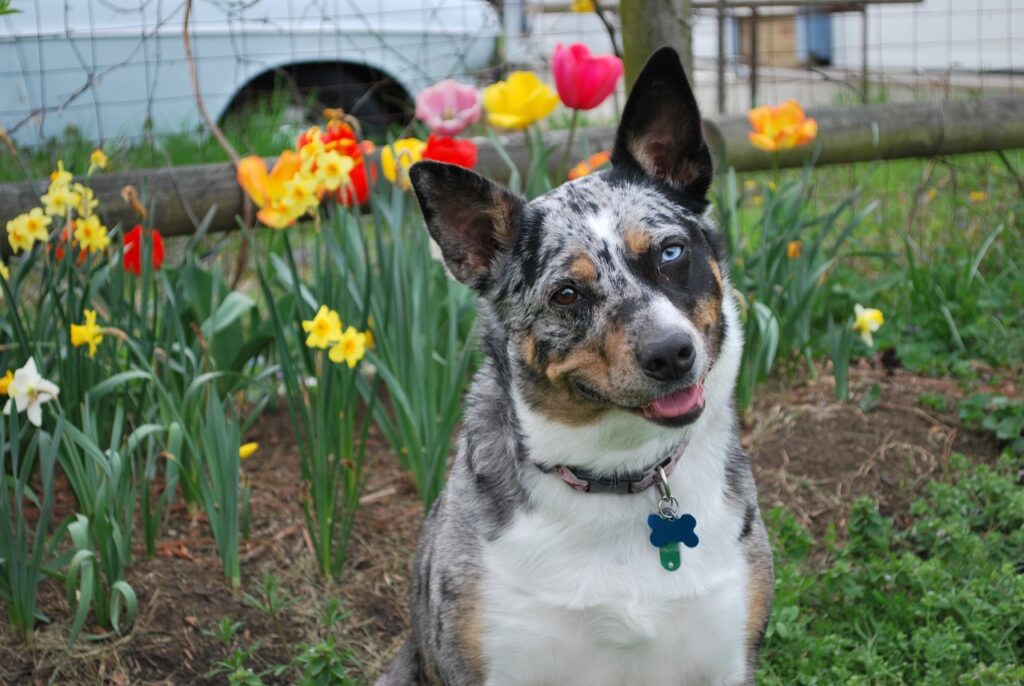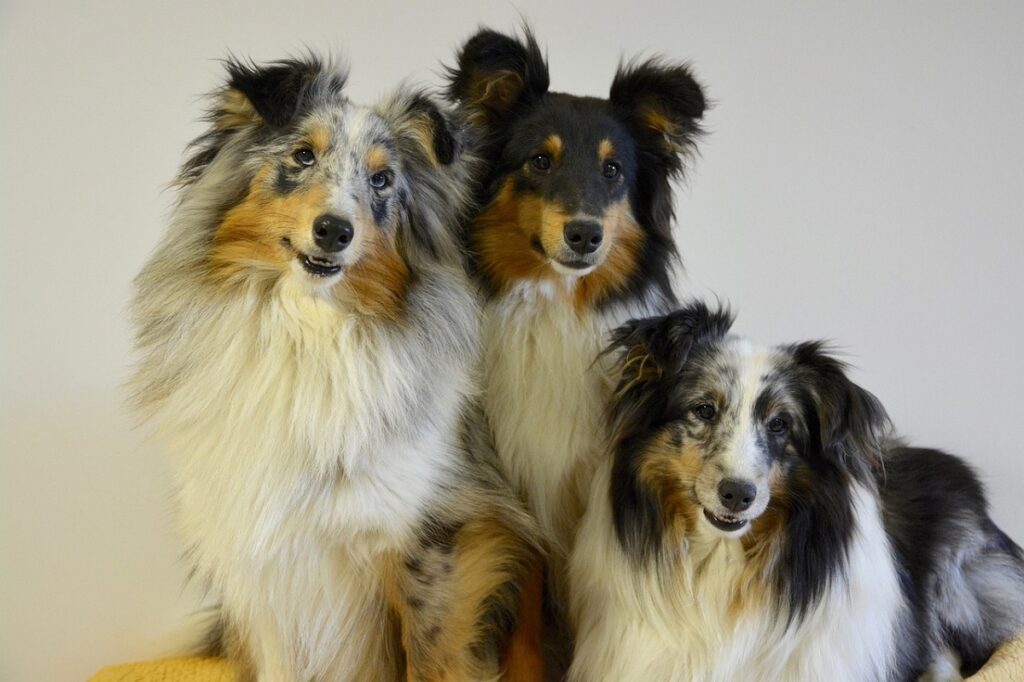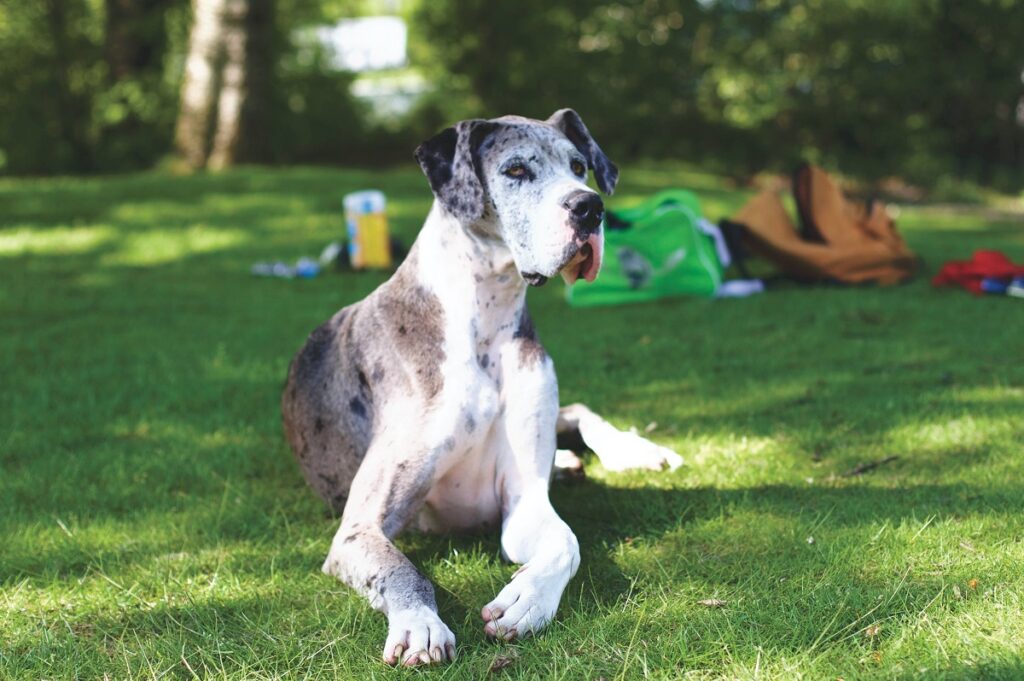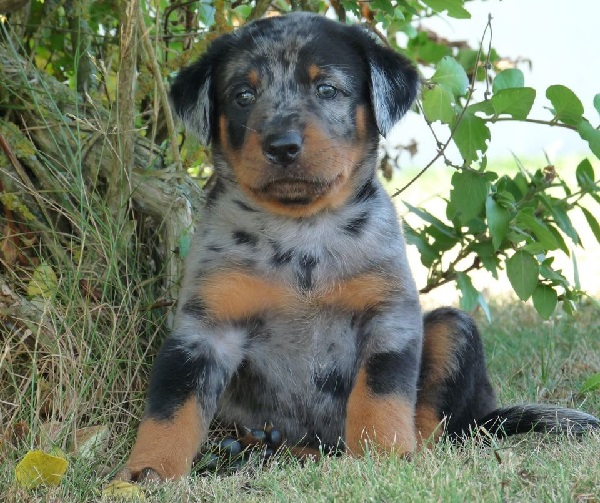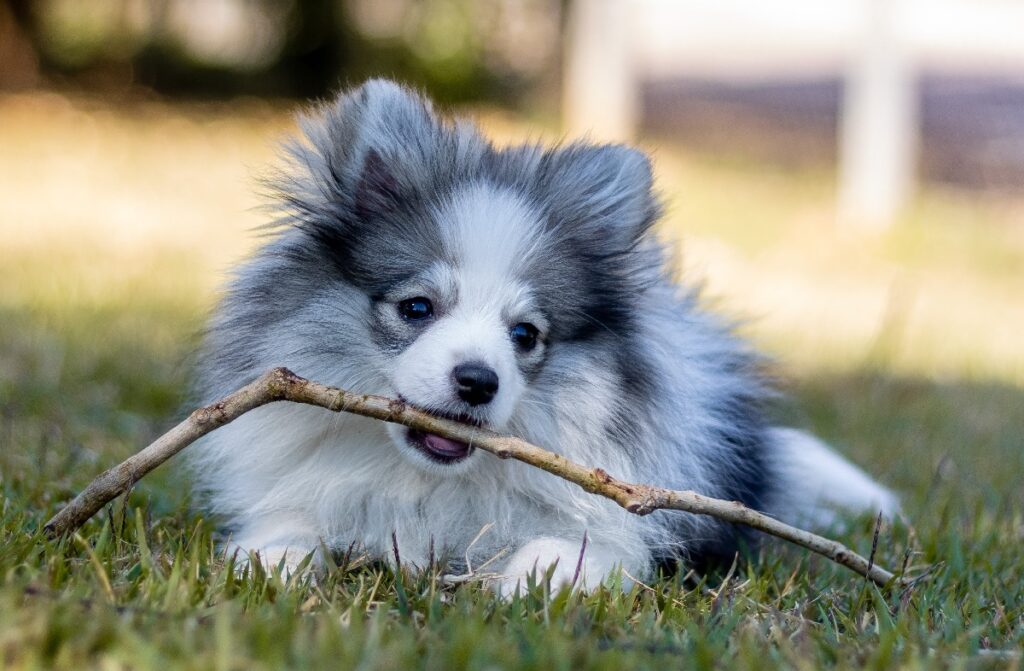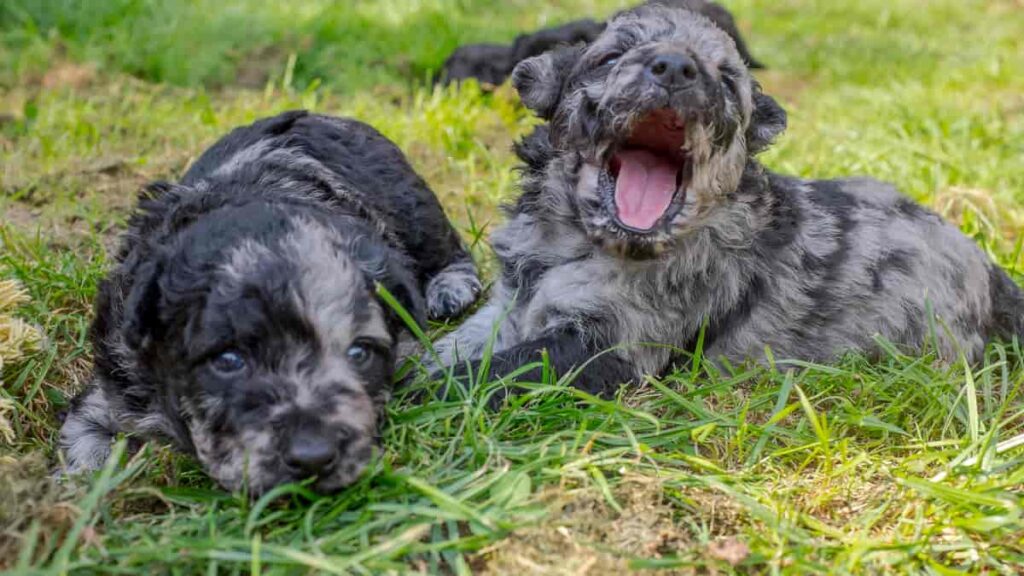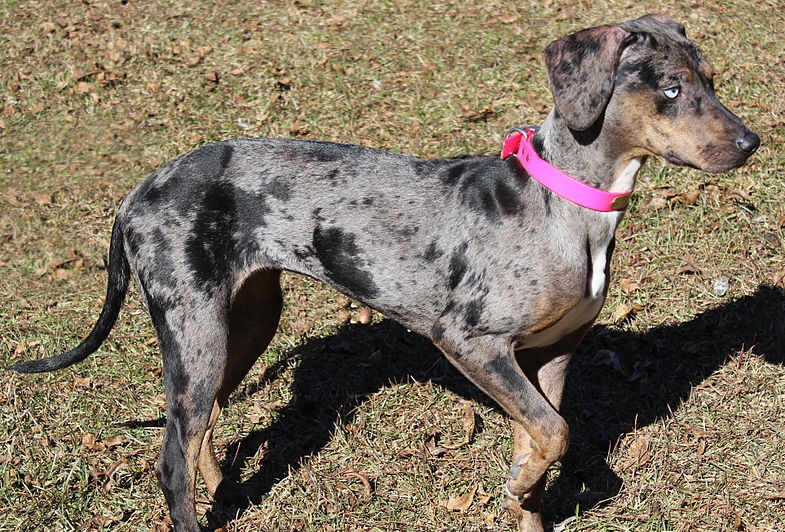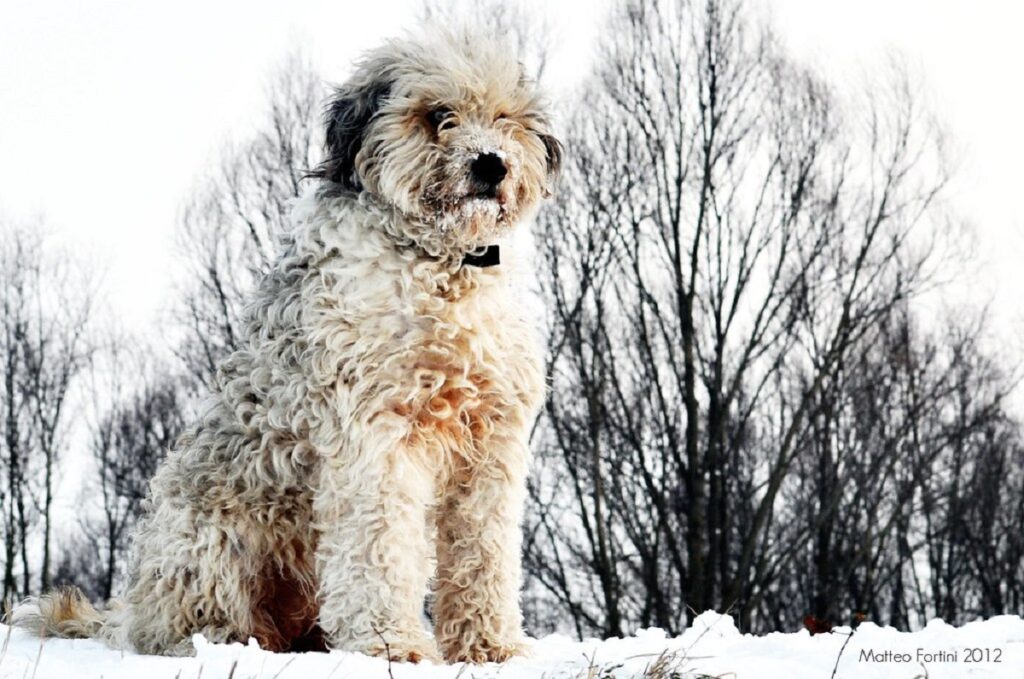Merle, a captivating coat pattern of mottled patches and dappled hues, transforms ordinary dog breeds into mesmerizing works of art. But beyond their striking appearance lies a fascinating genetic story. This exploration delves into the magic behind merle, uncovering the science responsible for these unique coat patterns, the breeds that carry this distinctive trait, and the important health considerations that accompany this beautiful, yet sometimes complex, genetic inheritance. Join us as we unravel the mystery and marvel at the splendor of merle dog breeds.
Merle dogs are simply stunning; there’s no other way to say it. They have a very distinguishable pattern of blue with black splotches that don’t form any cohesive pattern.
From their dappled coats to their distinct personalities, let’s learn what makes Merle breeds truly special.
What Is a Merle Dog?
A dog’s merle coat is actually a result of genetics, specifically, the semi-dominant merle (M) allele, which is also a known genetic mutation. This means only one dog has to have the gene responsible for the merle pattern in order to produce merle puppies.
The offspring lucky enough to have the pattern will contain a copy of the M and then a copy of the non-merle allele (m). There’s also the phantom merle or the cryptic merle that contains the necessary gene but doesn’t show it outwardly (they don’t have a Merle pattern coat, or the Merle pattern is very vague).
There are also dogs known as lethal whites (double merle dogs), and this is as bad as it sounds. Lethal whites are a result of breeding two merle dogs with each other, a no-no when it comes to breeding standards.
Many people who do it are irresponsible breeders who are trying to increase their chances of producing offspring with the patterns. What it does, in fact, is create significant health issues that create suffering for the pup. Lethal whites often fail to develop properly, suffer blindness and deafness, and many are known to die shortly after birth.
When considering adopting a merle dog, please do your research and only adopt from a reputable breeder who can provide you with all of the information on the bloodlines and engage in selective breeding. Otherwise, you’ll run the risk of adopting merle dogs, which will cost you a lot of money on healthcare.
Merle Dog Breeds
There are a variety of merle dogs available, ranging from toy breeds to gentle giants. This list is just the beginning, as almost any dog can have the Merle gene, but it’s very critical to pay attention to breeder standards.
Let’s take a look at a few of our top merle coat dog breed choices.
1. Chihuahua
| Group | Toy |
| Dog’s Size | 5″ to 8″ |
| Weight | up to 6 pounds |
| Fur and Color | Short or medium-length smooth coat; black, black and tan, cream, chocolate, fawn, red, combinations thereof, sable, or merle. |
| Lifespan | 14 to 16 years |
If you’re looking for a sweet bundle in a little package, you’ll find it in the Chihuahua. Merle Chihuahuas are something to behold, too, with their gorgeous mottled pattern, though they are very rare.
Chihuahuas don’t often have the Merle gene, and those that do aren’t allowed by the American Kennel Club (AKC) because it’s usually a result of crossbreeding.
One thing you’ll learn with Chihuahuas is that they demand your attention, and they need training. The Chihuahua merle dog is a happy little lap dog when it’s properly trained.
2. Poodle
| Group | Non-Sporting |
| Dog’s Size | Three sizes: over 15″ (Standard); 10″ to 15″ (Miniature); up to 10″ (Toy) |
| Weight | 40 to 70 pounds (Standard); 10 to 15 pounds (Miniature); 4 to 6 pounds (Toy) |
| Fur and Color | long curly coats; apricot, brown, blue, black, cream, red, silver, white, gray, merle |
| Lifespan | 10 to 18 years |
If you love a fun, intelligent pooch that comes with the merle pattern, you’ll definitely enjoy the Poodle. Poodles come in three different sizes: the Toy Poodle, miniature, and standard.
Poodles are one of the most popular dogs on this list because they’re easy to train, and those with merle coats are simply stunning.
The Poodle is a great family dog and gets along with other pets, including other dogs. Poodles rarely show aggression, choosing to love their people above all else. These merle dogs also make great travel companions.
3. Australian Shepherd
| Group | Herding |
| Dog’s Size | 18″ to 23″ |
| Weight | 40 to 65 pounds |
| Fur and Color | Double medium-length coat; black, red, blue merle, and red merle |
| Lifespan | 12 to 15 years |
If you’re looking for a herder with the merle patterning, you’ve come to the right spot with the Australian Shepherd. In fact, merle Australian Shepherds are one of the most common you’ll find when looking for this specific pattern.
Breeders often choose to mate one non-merle dog and one merle dog in order to create merle puppies. Even then, the entire litter isn’t merle, only about half.
This is not a breed for first-time dog owners. You also must have an active lifestyle. Australian Shepherds are working dogs and must be kept busy. They do love to snuggle with their owners, but that is after they’ve exhausted themselves.
4. French Bulldog
| Group | Non-Sporting |
| Dog’s Size | 11″ to 13″ |
| Weight | under 28 pounds |
| Fur and Color | Smooth, short coat; brindle, cream, fawn, white, or a combination thereof, or merle |
| Lifespan | 10 to 12 years |
The French Bulldog is the smallest of the types of Bulldogs, but don’t let that deter you. If you’ve never seen a Merle Frenchie, you’re in for a treat, as it’s not a very common color.
The French Bulldog is a very happy dog that loves to be with its owner. French Bulldogs are very feisty and love to have fun as well. Another thing that makes Frenchies so popular as a breed is that they are very devoted pups and will stick to their owners.
However, if you’re looking for a Merle French Bulldog, be prepared to pony up the bucks. They’re rare, so they’re costly, but Frenchies are worth the investment.
5. Border Collie
| Group | Herding |
| Dog’s Size | 18″ to 22″ |
| Weight | 30 to 55 pounds |
| Fur and Color | Wavy, medium-length double coat; black blue, red, sable, black and white, lilac, red merle, sable merle, blue merle, or any combination thereof |
| Lifespan | 12 to 15 years |
The Border Collie dog is another herding dog on the list of merle dog breeds that is regularly found with a merle pattern. This is a very affectionate dog that loves its people, especially children, but it’s also a dog with a purpose.
Border Collies don’t often do well in city environments unless they get a lot of exercise. If you have a Border Collie, it’s recommended you live on a decent parcel of land so it can run and wear itself out.
Idle Border Collies tend to become destructive. Additionally, the Border Collie is a very smart breed that is easy to train and loves to please its owner.
6. Smooth Collie
| Group | Herding |
| Dog’s Size | 22″ to 26″ |
| Weight | 50 to 75 pounds |
| Fur and Color | Rough short coat; blue merle, tricolor, sable and white |
| Lifespan | 12 to 14 years |
The Smooth Collie is one of the types of Collie breeds and is a gorgeous pup that is often mistaken for a shaved-down Border Collie. It is, in fact, its own breed and is also very active.
You must have room for this dog to run or a way to exercise it regularly. Smooth Collies are herding dogs that do well with other animals. The Smooth Collie isn’t an aggressive merle dog, but it is vocal.
You’ll need to train this pup not to bark indiscriminately; otherwise, you’ll have a hard time getting it to be quiet. Smooth Collies are very agile and do well in competitions.
7. Rough Collie
| Group | Herding |
| Dog’s Size | 20″ to 24″ |
| Weight | 40 to 65 pounds |
| Fur and Color | white, tricolor, sable, sable and white, sable merle, blue merle |
| Lifespan | 14 to 16 years |
Take the Smooth Collie and add some long fur and ta-da! You have a Rough Collie. Rough Collies are also affectionately known as Lassie dogs, as it’s the exact breed the hero pup was.
The Rough Collie is the Border Collie’s cousin, and the merle pattern is more prominent in this breed today than in the past because of its popularity. However, Rough Collies still have white patches on their chest and legs.
Rough Collies are great family pets and companion dogs, but they require daily grooming to remain tangle-free. Rough Collies are fast, strong dogs and are known for protecting what’s theirs, whether it be people or livestock.
8. Dapple Dachshund
| Group | Hound |
| Dog’s Size | Two sizes: 8″ to 9″ (Standard); 5″ to 6″ (Miniature) |
| Weight | 16 to 32 pounds (Standard); up to 11 pounds (Miniature) |
| Fur and Color | Short or long smooth coats; black and tan, chocolate and tan, cream, wild boar, wheaten, red, blue and tan, and others, including dapple. |
| Lifespan | 12 to 16 years |
The Dapple Dachshund is a Dachshund that has a merle pattern; only the pattern is known as dapple in this breed. It’s a very rare sight, too, but the AKC allows owners to register Dachshunds with these markings.
Dachshunds have a great personality, and they are loyal pups who, quite often, aren’t aware of their size — they tend to act much bigger.
However, the Dachshund is a very loyal pup and, while small, has a ton of stamina that’s noticeable in their running spurts.
9. Cardigan Welsh Corgi
| Group | Herding |
| Dog’s Size | 10.5″ to 12.5″ |
| Weight | 25 to 38 pounds |
| Fur and Color | Double medium-length coat; black and white, brindle and white, red and white, blue merle and white, among others |
| Lifespan | 12 to 15 years |
The Cardigan Welsh Corgi is similar in build to the Pembroke Welsh Corgi, but they don’t have docked tails. Merle Corgis are more popular in the Cardigan breed than the Pembroke Welsh Corgi, which the AKC doesn’t allow the mottled pattern.
However, this is one of the merle dog breeds that are very sweet and affectionate and has an all-around lovely personality that makes people fall in love with them right away, which is great because they are very social and are especially drawn to children. Plus, they’re highly intelligent and learn very quickly.
10. Pyrenean Shepherd
| Group | Herding |
| Dog’s Size | 15″ to 20.5″ |
| Weight | 15 to 30 pounds |
| Fur and Color | Smooth or rough medium-length coat; fawn, brindle, black, greay, slate gray, brindle, black and white, or merle varieties |
| Lifespan | 17 to 19 years |
The Pyrenean Shepherd is one of the types of Shepherd dog on our list. This French herding dog is not very popular in the United States, but its merle patterning is simply gorgeous, which is why it’s on this list.
Pyrenean Shepherds are flock guardians; they protect sheep and are very energetic because of the work they do.
They are also very intelligent, and if you own a Pyrenean Shepherd, be prepared to shake your head at all of its mischievous actions. They bond very closely with their owners and love games that keep them mentally and physically stimulated.
11. Koolie
| Group | Not recognized by the American Kennel Club (or any club) |
| Dog’s Size | 16″ to 22″ |
| Weight | 30 to 55 pounds |
| Fur and Color | Short smooth coat; merle, tri-color, red, chocolate, black |
| Lifespan | 12 to 18 years old |
If you’re looking for one of the merle dog breeds you’ve probably not heard much about, let me introduce the Koolie.
This adorable-looking merle dog is another high-energy breed that you will need to either have some land and a job for, or a way to exercise them — agility sports are a great idea for Koolies! In fact, they’re becoming exceedingly popular in the US simply for this reason.
Outside of working, the Koolie is a friendly and obedient pup that is social and gets along with other animals, people, and children. Their large ears and happy disposition make it hard not to love them back.
12. Shetland Sheepdog
| Group | Herding |
| Dog’s Size | 13″ to 16″ |
| Weight | 15 to 25 pounds |
| Fur and Color | Long double coat; sable and white, blue merle and white, black and white, black white and tan, sable merle and white, and other combinations thereof. |
| Lifespan | 12 to 14 years |
Shetland Sheepdogs, or Shelties as they’re referred to, are one of the merle dog breeds that were originally bred to herd but have become a staple in competitive sports, especially agility. The Shetland Sheepdog is another highly intelligent merle dog breed that also has a happy disposition and is eager to please its owner.
Indoors, Shelties are very affectionate family dogs who adapt very easily to their households. You can count on the Shetland Sheepdog to be a great watchdog too, because this merle dog is wary of strangers and is very vocal.
They are also very sensitive dogs, which can be prone to separation anxiety, so training is essential before you leave this pup alone for long periods of time.
13. Great Danes
| Group | Working |
| Dog’s Size | 28″ to 32″ |
| Weight | 110 to 175 pounds |
| Fur and Color | Short, smooth coat; black, black and white, Harlequin, mantle, merle, fawn, blue, brindle |
| Lifespan | 7 to 10 years |
If you want a giant 110-pound-plus pup that falls into the merle dog breeds category who wants nothing else than to cuddle up in your lap, the Great Dane is your dog.
However, a word of caution. When shopping for Great Danes with Merle patterns, make sure you avoid a double Merle Great Dane because you will be saddled with a wealth of health issues.
However, despite their short lifespans, the Great Dane is a loyal, faithful companion that you will never regret owning. Despite their large size, Great Danes are truly considered gentle giants. They love their owners, bonding with them deeply, and are excellent with children.
14. Beauceron
| Group | Herding |
| Dog’s Size | 24″ to 27.5″ |
| Weight | 70 to 110 pounds |
| Fur and Color | Smooth, short double coat; Harlequin, black and rust, gray black and tan, black and tan, merle coat pattern |
| Lifespan | 10 to 12 years |
The Beauceron is another French herding dog like the Pyrenean Shepherd, but this one is much larger in stature.
It’s not a popular dog in the US at all, but the Beauceron definitely has its place in France as a watchdog because of its fearless and protective nature and aids in search and rescue missions.
As a pet, the Beauceron is a friendly and calm dog that is fiercely devoted to its people. It’s also a very smart breed, so it catches on to new tasks and training very easily. Reward-based training is the best method for a Beauceron, as harsh methods do not work well.
15. Pomeranian
| Group | Toy |
| Dog’s Size | 6″ to 7″ |
| Weight | 3 to 7 pounds |
| Fur and Color | Long double coat; blue merle, chocolate, black, blue, orange, red, beaver, sable, blue and tan, and combinations thereof |
| Lifespan | 12 to 16 years |
Pomeranians are cute balls of fluff. Add the Merle coat pattern? They’re simply irresistible! The Pomeranian is a loving dog that is more than content to spend its days on the couch with its owner.
It doesn’t have high energy needs, but if you have a Pomeranian, know that it will suffer separation anxiety if you are away for long periods of time.
Pomeranians love to play with their owners and are known for their fierce loyalty. They also forget their size, so if you see a Pomeranian barking in warning, know it’s simply looking out for its people.
16. Mudi
| Group | Herding |
| Dog’s Size | 15″ to 18.5″ |
| Weight | 18 to 29 pounds |
| Fur and Color | Curly, medium-length coat; black, white, yellow, gray, gray-brown, brown |
| Lifespan | 12 to 14 years |
The Mudi is another not very common merle dog on the list. This breed hails from Europe, where it’s mostly remained, but you cannot deny the simply gorgeous merle coat with its mottled patches on this breed.
If you’re entertaining the idea of a Mudi, know that they are not for first-time dog owners. They’re very high-strung and need a lot of attention to fight off destructive behaviors that include fearfulness, separation anxiety, and nervousness.
However, on the flip side, this pup is very intelligent and adaptable, and if you put it to work, you won’t be sorry.
17. Catahoula Leopard Dog
| Group | Foundation Stock Service |
| Dog’s Size | 22″ to 24″ |
| Weight | 50 to 95 pounds |
| Fur and Color | Smooth short coat; black, yellow, blue, red, chocolate, brindle, blue merle |
| Lifespan | 10 to 14 years |
I once owned a Catahoula Leopard Dog mix, and she was one of the sweetest girls I’ve ever had. The Catahoula was originally bred as a hunter of feral pigs and is well-known for its work ethic.
This merle dog breed is very athletic, and if you own a Catahoula, you will need to be prepared for the amount of exercise it needs. It is an easy dog to train, but the Catahoula can be stubborn too, which means you will need to consistently reinforce what you’ve taught.
On the flip side, owning a Catahoula means you’ll never be lacking a faithful companion.
18. Bergamasco Shepherd
| Group | Herding |
| Dog’s Size | 22″ to 23.5″ |
| Weight | 57 to 84 pounds |
| Fur and Color | Long corded coats; gray or black, merle |
| Lifespan | 13 to 15 years |
If you want a merle dog that can double as a mop, you’ll find it in the Bergamasco Shepherd. This breed has a long corded coat that naturally forms dreadlocks — no work needed on your part!
The coat on the Bergamasco Shepherd is a testament to the breed’s strength and hardiness because it used to shield the dogs from heavy rains, cold temperatures, and strong winds.
They are a vigilant breed that is known for their independence, but bringing a Bergamasco Shepherd into your home is very possible with the right amount of training.
What is a Double Merle Dog?
Double merle dogs are those borne of two merle dogs and contain two merle alleles. Breeders are strongly advised not to breed two merle dogs together because of the negative health consequences involved, namely blindness and deafness.
Double merle dogs have an MM genotype, which means they inherited two copies of the dominant M gene.
While one would think that it’s a good thing for the coloring and pattern, it actually impairs the body’s ability to make pigment. Therefore, double merle puppies with the MM genotype, the merle gene, are mainly white with a few merle spots.
Merle Dog Temperament
The Merle coat pattern doesn’t necessarily have anything to do with the dog’s personality. In fact, you should look to the breed and its temperament to learn more if you’re curious about merle dogs because it’s more about the personality traits than the coloring.
If you look at the list above, you’ll notice that a lot of the merle dogs fall into the working dogs category. These types of dogs are typically very intelligent, high energy, and love being given jobs. These merle dogs are also very easy to train.
The AKC and Merle Dogs
While the AKC is very specific about coloring — and they outline all the accepted colors on their website — they also recognize that Merle is common enough in specific Merle dogs. It’s considered one of their standard colors.
These include the following dog breeds:
- Australian Shepherd
- Chihuahua
- Great Dane
- Border Collie
- Shetland Sheepdog
- Dachshund
- Cardigan Welsh Corgi
- Catahoula Leopard Dog
Patterns Often Mistaken for Merle
The merle pattern is very recognizable to those who are familiar with it, but there are a few other patterns that people mistake for merle. These include harlequin and brindle.
However, the merle pattern is distinguishable by its blue coloring and mottled black patches that almost look like marble.
FAQs
Do All Merle Dogs Have Blue Eyes?
No. While it may seem that all merle dogs have blue eyes, many have brown eyes. They might also have heterochromia, a condition that causes two different colored eyes. In dogs, that might result in them having one blue eye and one brown eye.
Why Are Merle Dog Breeds More Expensive?
Merle dog breeds are typically more expensive because of the patterns they exhibit. Breeding these types of dogs requires more attention to genetics. In some breeds, it’s not intentional, and in others, it’s exceedingly rare, so that drives the price up. So does supply and demand.
The fewer dogs with merle patterning and the more people that want them results in dog breeders raising prices. It also helps to weed out those who simply want a designer dog.
How Much Do Merle Dogs Cost?
This answer is very subjective; it honestly depends on the breeder and the actual breed of Merle dogs. In a French Bulldog or Chihuahua, for example, you’re likely to pay more for a merle pup than you are for a Border Collie or Australian Shepherd, where the pattern is common. Expect to pay between $1,000 to $3,000.
Is Merle Rare in Dogs?
Not really. In some breeds, it’s rare, but in general, it’s a very common color pattern caused by the ever-prominent merle gene. It’s also highly sought after by some people.
What dogs carry the Merle gene naturally?
There are many dogs that carry the Merle gene naturally, and they’re the breeds that you regularly see that mottled pattern in.
For example, Australian Shepherds, Shetland Sheepdogs, Rough Collies, Koolies, and Catahoula Leopard Dogs all come by the gene naturally. These are also the breeds that the AKC recognizes the pattern in as standard.
Wrap-up
If you’re anything like me, you see the beauty in all dogs but are especially drawn to those with the unique Merle coat pattern. I have always had a love for merle dogs and even had a Catahoula once upon a time.
However, I caution that you should never look for a pup based on its color alone. Research is key to adopting any type of dog, no matter its coloring. Some personalities won’t mesh; some will be too big for your home, like the Great Pyrenees.
Many of the merle dogs on this list tend to be high-energy or high-strung, a combination that is only handled by experienced dog owners. Do yourself — and especially the dog — a favor and really know what you’re getting into before you take the plunge based on its gorgeous coat.
Now that you’ve read about merle dogs check out our list of top dog breeds with blue eyes!
Merle dogs, with their captivating mottled coats, are truly unique. The merle gene, while responsible for their striking appearance, also carries potential health risks that responsible breeders must carefully manage. Understanding the genetics behind the merle pattern empowers owners to make informed decisions and prioritize the well-being of these special breeds. From the playful Australian Shepherd to the loyal Catahoula Leopard Dog, merle dogs enrich our lives with their beauty and individuality. By embracing ethical breeding practices and prioritizing their health, we can ensure these magical dogs continue to thrive.

